The Cambridge History of Japan, Vol. 3: Medieval Japan
Подождите немного. Документ загружается.

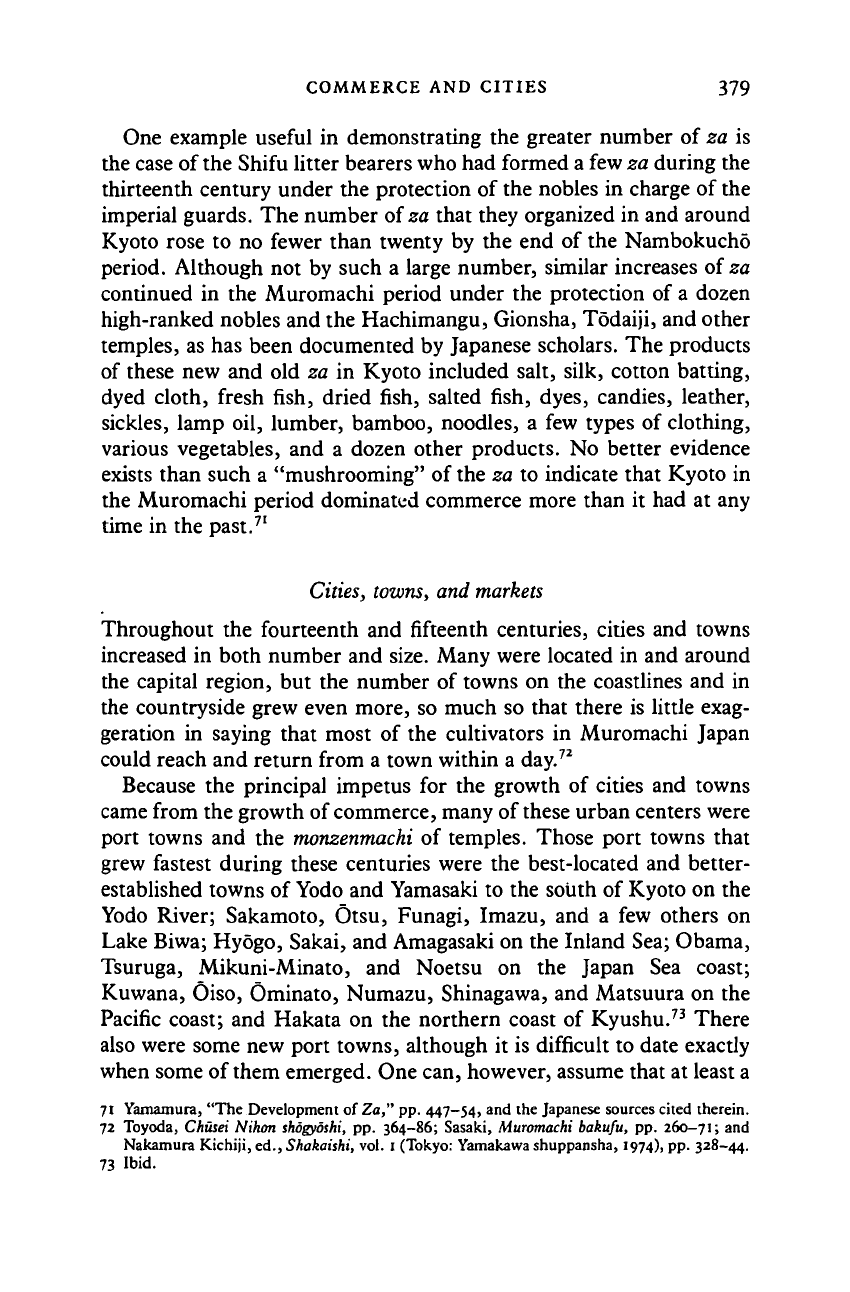
COMMERCE AND CITIES 379
One example useful in demonstrating the greater number of za is
the case of the Shifu litter bearers who had formed a few za during the
thirteenth century under the protection of the nobles in charge of the
imperial guards. The number of za that they organized in and around
Kyoto rose to no fewer than twenty by the end of the Nambokucho
period. Although not by such a large number, similar increases of za
continued in the Muromachi period under the protection of a dozen
high-ranked nobles and the Hachimangu, Gionsha, Todaiji, and other
temples, as has been documented by Japanese scholars. The products
of these new and old za in Kyoto included salt, silk, cotton batting,
dyed cloth, fresh fish, dried fish, salted fish, dyes, candies, leather,
sickles, lamp oil, lumber, bamboo, noodles, a few types of clothing,
various vegetables, and a dozen other products. No better evidence
exists than such a "mushrooming" of the za to indicate that Kyoto in
the Muromachi period dominated commerce more than it had at any
time in the past.
71
Cities, towns, and markets
Throughout the fourteenth and fifteenth centuries, cities and towns
increased in both number and size. Many were located in and around
the capital region, but the number of towns on the coastlines and in
the countryside grew even more, so much so that there is little exag-
geration in saying that most of the cultivators in Muromachi Japan
could reach and return from a town within a day.
72
Because the principal impetus for the growth of cities and towns
came from the growth of commerce, many of these urban centers were
port towns and the monzenmachi of temples. Those port towns that
grew fastest during these centuries were the best-located and better-
established towns of Yodo and Yamasaki to the south of Kyoto on the
Yodo River; Sakamoto, Otsu, Funagi, Imazu, and a few others on
Lake Biwa; Hyogo, Sakai, and Amagasaki on the Inland Sea; Obama,
Tsuruga, Mikuni-Minato, and Noetsu on the Japan Sea coast;
Kuwana, Oiso, Ominato, Numazu, Shinagawa, and Matsuura on the
Pacific coast; and Hakata on the northern coast of Kyushu.
73
There
also were some new port towns, although it is difficult to date exactly
when some of them emerged. One can, however, assume that at least a
71 Yamamura, "The Development of Za," pp. 447-54, and the Japanese sources cited therein.
72 Toyoda, Chiisei Nikon shogyoshi, pp. 364-86; Sasaki, Muromachi bakufu, pp.
260-71;
and
Nakamura Kichiji, ed.,Shakaishi, vol.
1
(Tokyo: Yamakawa shuppansha, 1974), pp. 328-44.
73 Ibid.
Cambridge Histories Online © Cambridge University Press, 2008
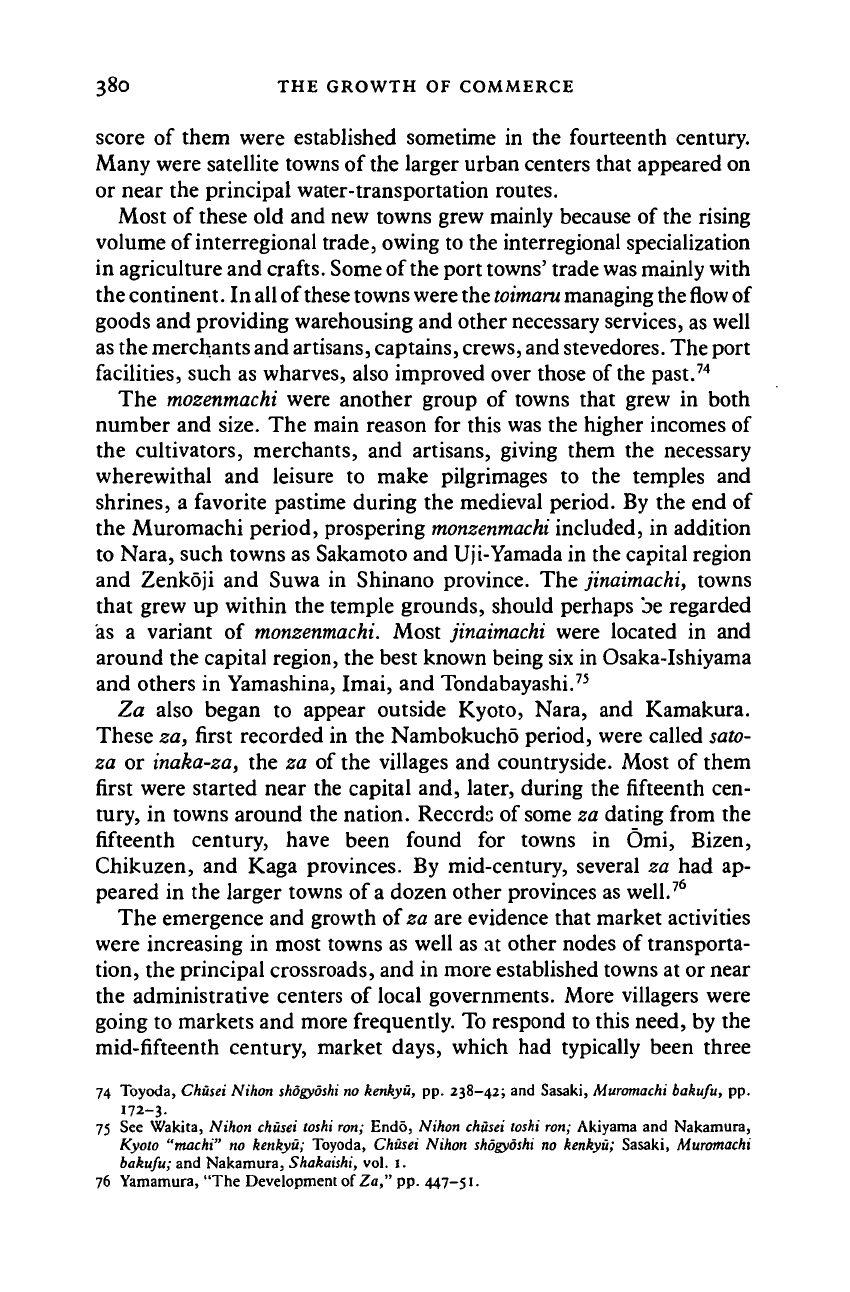
380 THE GROWTH OF COMMERCE
score of them were established sometime in the fourteenth century.
Many were satellite towns of the larger urban centers that appeared on
or near the principal water-transportation routes.
Most of these old and new towns grew mainly because of the rising
volume of interregional trade, owing to the interregional specialization
in agriculture and crafts.
Some
of the port towns' trade
was
mainly with
the continent. In
all
of these towns
were the toimaru
managing
the
flow
of
goods and providing warehousing and other necessary services, as well
as
the
merchants and
artisans,
captains,
crews,
and
stevedores.
The port
facilities, such as wharves, also improved over those of the past.
74
The
mozenmachi
were another group of towns that grew in both
number and size. The main reason for this was the higher incomes of
the cultivators, merchants, and artisans, giving them the necessary
wherewithal and leisure to make pilgrimages to the temples and
shrines, a favorite pastime during the medieval period. By the end of
the Muromachi period, prospering
monzenmachi
included, in addition
to Nara, such towns as Sakamoto and Uji-Yamada in the capital region
and Zenkoji and Suwa in Shinano province. The
jinaimachi,
towns
that grew up within the temple grounds, should perhaps be regarded
as a variant of
monzenmachi.
Most
jinaimachi
were located in and
around the capital region, the best known being six in Osaka-Ishiyama
and others in Yamashina, Imai, and Tondabayashi.
75
Za also began to appear outside Kyoto, Nara, and Kamakura.
These za, first recorded in the Nambokucho period, were called
sato-
za or inaka-za, the za of the villages and countryside. Most of them
first were started near the capital and, later, during the fifteenth cen-
tury, in towns around the nation. Records of some za dating from the
fifteenth century, have been found for towns in Omi, Bizen,
Chikuzen, and Kaga provinces. By mid-century, several za had ap-
peared in the larger towns of
a
dozen other provinces as well.
76
The emergence and growth of za are evidence that market activities
were increasing in most towns as well as at other nodes of transporta-
tion, the principal crossroads, and in more established towns at or near
the administrative centers of local governments. More villagers were
going to markets and more frequently. To respond to this need, by the
mid-fifteenth century, market days, which had typically been three
74 Toyoda, Chusei Nihon
shogyoshi
no kenkyu, pp. 238-42; and Sasaki, Muromachi bakufu, pp.
172-3.
75 See Wakita, Nihon chusei toshi ron; Endo, Nihon chusei toshi ron; Akiyama and Nakamura,
Kyoto "machi" no kenkyu; Toyoda, Chusei Nihon shogyoshi no kenkyu; Sasaki, Muromachi
bakufu; and Nakamura, Shakaishi, vol. I.
76 Yamamura, "The Development of Za," pp.
447-51.
Cambridge Histories Online © Cambridge University Press, 2008
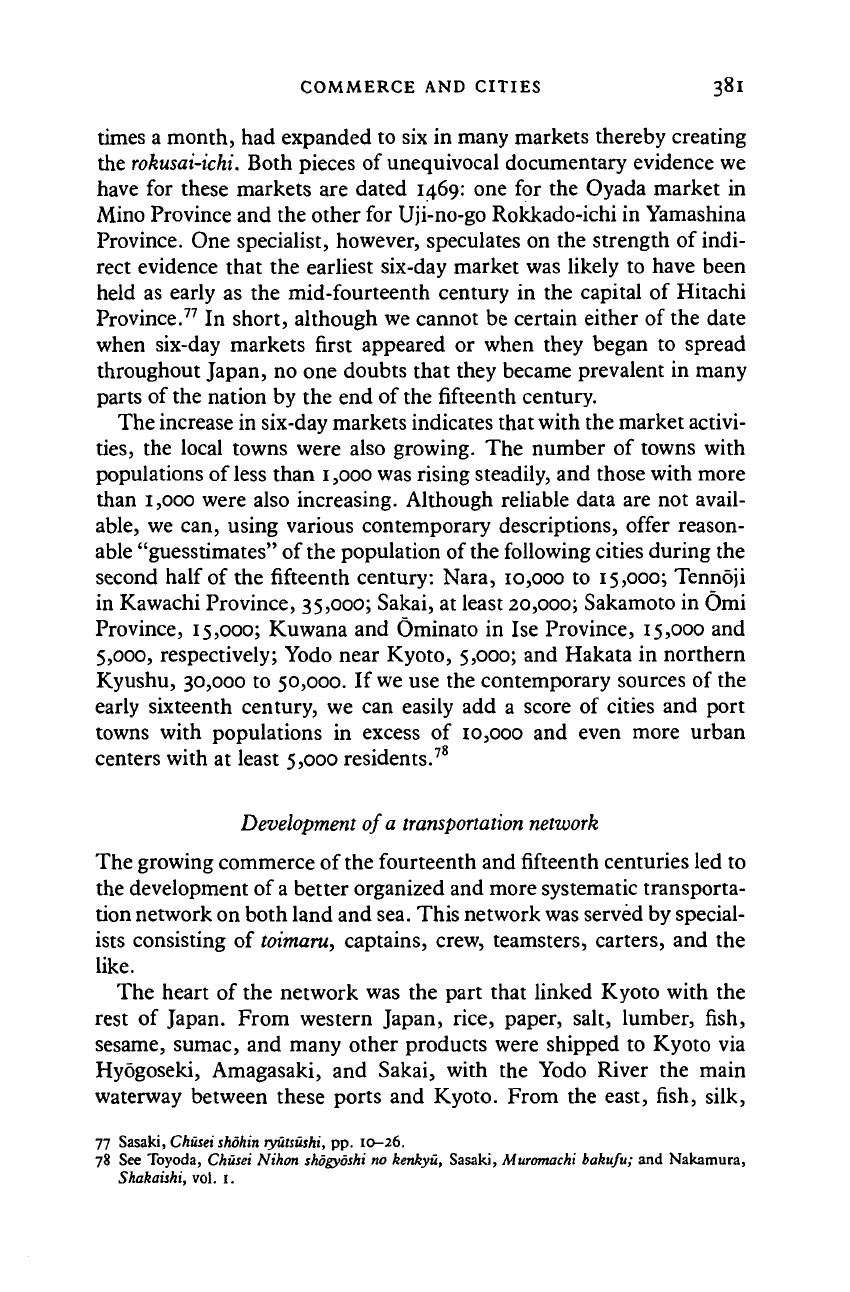
COMMERCE AND CITIES 381
times a month, had expanded to six in many markets thereby creating
the
rokusai-ichi.
Both pieces of unequivocal documentary evidence we
have for these markets are dated 1469: one for the Oyada market in
Mino Province and the other for Uji-no-go Rokkado-ichi in Yamashina
Province. One specialist, however, speculates on the strength of indi-
rect evidence that the earliest six-day market was likely to have been
held as early as the mid-fourteenth century in the capital of Hitachi
Province.
77
In short, although we cannot be certain either of the date
when six-day markets first appeared or when they began to spread
throughout Japan, no one doubts that they became prevalent in many
parts of the nation by the end of the fifteenth century.
The increase in six-day markets indicates that with the market activi-
ties, the local towns were also growing. The number of towns with
populations of less than 1,000 was rising steadily, and those with more
than 1,000 were also increasing. Although reliable data are not avail-
able,
we can, using various contemporary descriptions, offer reason-
able "guesstimates" of the population of the following cities during the
second half of the fifteenth century: Nara, 10,000 to 15,000; Tennoji
in Kawachi Province, 35,000; Sakai, at least 20,000; Sakamoto in Omi
Province, 15,000; Kuwana and Ominato in Ise Province, 15,000 and
5,000, respectively; Yodo near Kyoto, 5,000; and Hakata in northern
Kyushu, 30,000 to 50,000. If we use the contemporary sources of the
early sixteenth century, we can easily add a score of cities and port
towns with populations in excess of 10,000 and even more urban
centers with at least
5,000
residents.
78
Development of a
transportation
network
The growing commerce of the fourteenth and fifteenth centuries led to
the development of
a
better organized and more systematic transporta-
tion network on both land and sea. This network was served by special-
ists consisting of toimaru, captains, crew, teamsters, carters, and the
like.
The heart of the network was the part that linked Kyoto with the
rest of Japan. From western Japan, rice, paper, salt, lumber, fish,
sesame, sumac, and many other products were shipped to Kyoto via
Hyogoseki, Amagasaki, and Sakai, with the Yodo River the main
waterway between these ports and Kyoto. From the east, fish, silk,
77 Sasaki,
Chusei shohin
tyutsushi, pp. 10-26.
78 See Toyoda, Chusei Nihon
shogyoshi
no kenkyu, Sasaki,
Muromachi
bakufu; and Nakamura,
Shakaishi, vol. I.
Cambridge Histories Online © Cambridge University Press, 2008
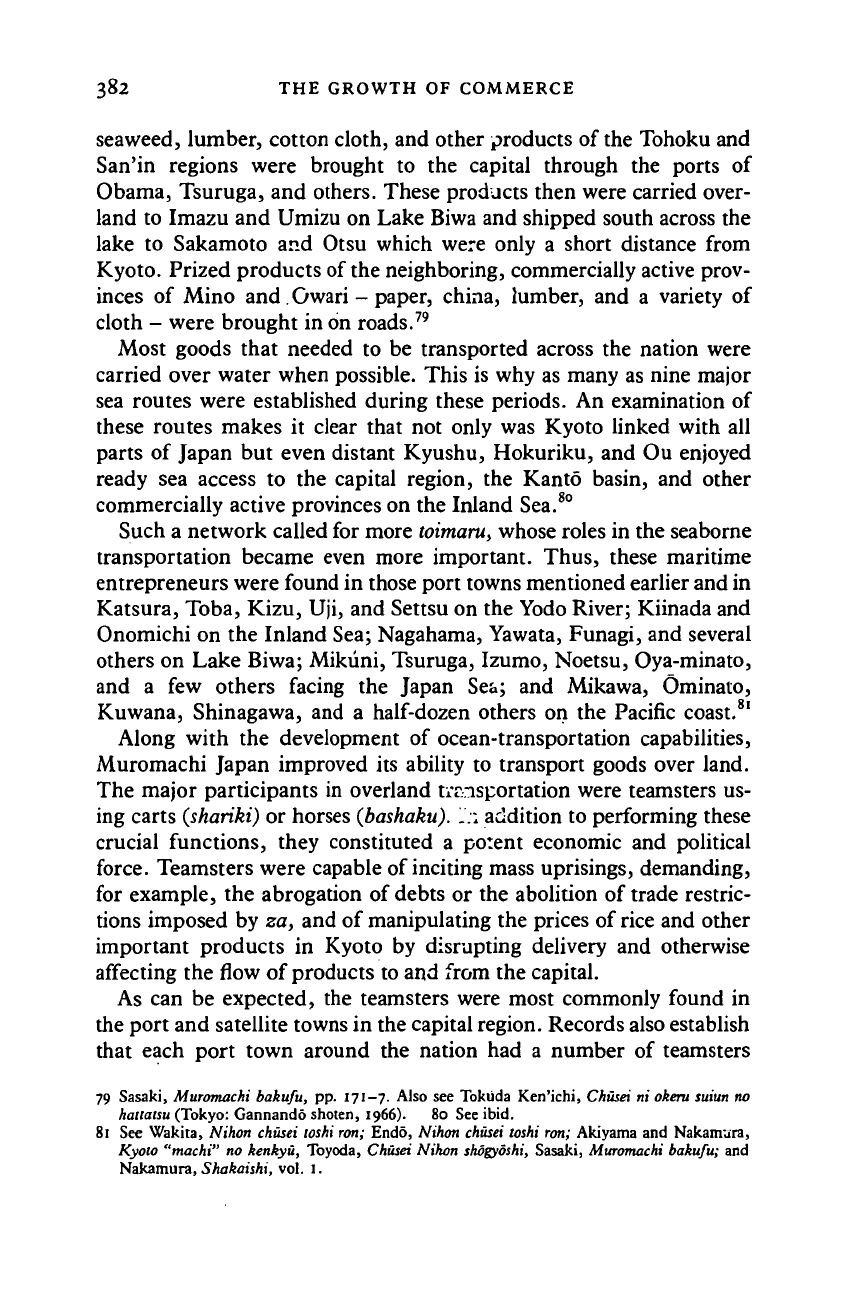
382 THE GROWTH OF COMMERCE
seaweed, lumber, cotton cloth, and other products of the Tohoku and
San'in regions were brought to the capital through the ports of
Obama, Tsuruga, and others. These products then were carried over-
land to Imazu and Umizu on Lake Biwa and shipped south across the
lake to Sakamoto and Otsu which were only a short distance from
Kyoto. Prized products of the neighboring, commercially active prov-
inces of Mino and.
Owari
- paper, china, lumber, and a variety of
cloth - were brought in on roads.
79
Most goods that needed to be transported across the nation were
carried over water when possible. This is why as many as nine major
sea routes were established during these periods. An examination of
these routes makes it clear that not only was Kyoto linked with all
parts of Japan but even distant Kyushu, Hokuriku, and Ou enjoyed
ready sea access to the capital region, the Kanto basin, and other
commercially active provinces on the Inland Sea.
80
Such a network called for more
toimaru,
whose roles in the seaborne
transportation became even more important. Thus, these maritime
entrepreneurs were found in those port towns mentioned earlier and in
Katsura, Toba, Kizu, Uji, and Settsu on the Yodo River; Kiinada and
Onomichi on the Inland Sea; Nagahama, Yawata, Funagi, and several
others on Lake Biwa; Mikuni, Tsuruga, Izumo, Noetsu, Oya-minato,
and a few others facing the Japan Sea; and Mikawa, Ominato,
Kuwana, Shinagawa, and a half-dozen others on the Pacific coast.
8
'
Along with the development of ocean-transportation capabilities,
Muromachi Japan improved its ability to transport goods over land.
The major participants in overland transportation were teamsters us-
ing carts
(shariki)
or horses
(bashaku).
1.; addition to performing these
crucial functions, they constituted a potent economic and political
force. Teamsters were capable of inciting mass uprisings, demanding,
for example, the abrogation of debts or the abolition of trade restric-
tions imposed by za, and of manipulating the prices of rice and other
important products in Kyoto by disrupting delivery and otherwise
affecting the flow of products to and from the capital.
As can be expected, the teamsters were most commonly found in
the port and satellite towns in the capital region. Records also establish
that each port town around the nation had a number of teamsters
79 Sasaki, Muromachi bakufu, pp. 171-7. Also see Tokuda Ken'ichi, Chusei ni
okeru
suiun no
hatlatsu (Tokyo: Gannando shoten, 1966). 80 See ibid.
81 See Wakita, Nihon chusei toshi ron; Endo, Nihon
chusei
toshi ron; Akiyama and Nakamura,
Kyoto "machi" no kenkyu, Toyoda, Chusei Nihon
shogyoshi,
Sasaki, Muromachi bakufu; and
Nakamura, Shakaishi, vol. 1.
Cambridge Histories Online © Cambridge University Press, 2008
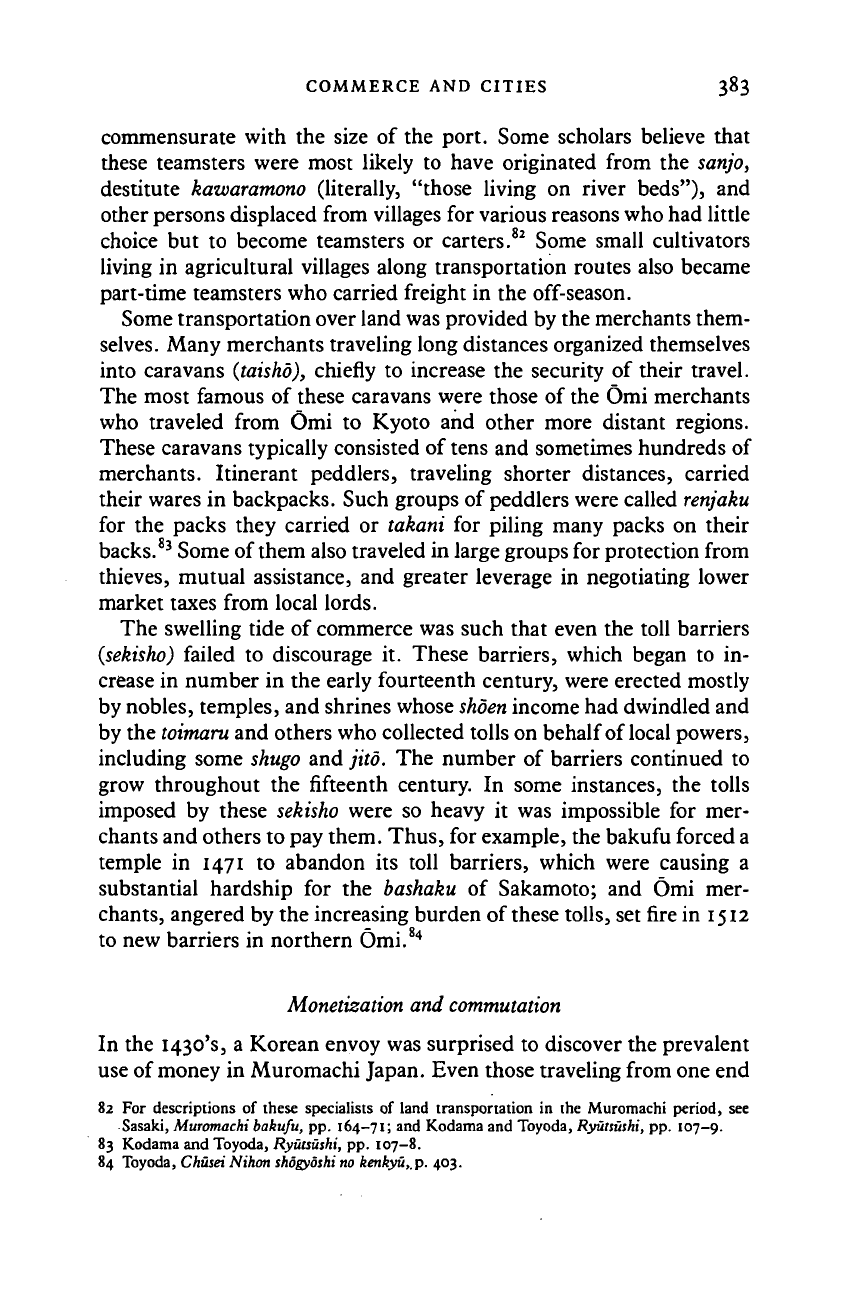
COMMERCE AND CITIES 383
commensurate with the size of the port. Some scholars believe that
these teamsters were most likely to have originated from the sanjo,
destitute kawaramono (literally, "those living on river beds"), and
other persons displaced from villages for various reasons who had little
choice but to become teamsters or carters.
82
Some small cultivators
living in agricultural villages along transportation routes also became
part-time teamsters who carried freight in the off-season.
Some transportation over land was provided by the merchants them-
selves. Many merchants traveling long distances organized themselves
into caravans (taisho), chiefly to increase the security of their travel.
The most famous of these caravans were those of the Omi merchants
who traveled from Omi to Kyoto and other more distant regions.
These caravans typically consisted of tens and sometimes hundreds of
merchants. Itinerant peddlers, traveling shorter distances, carried
their wares in backpacks. Such groups of peddlers were called renjaku
for the packs they carried or takani for piling many packs on their
backs.
83
Some of them also traveled in large groups for protection from
thieves, mutual assistance, and greater leverage in negotiating lower
market taxes from local lords.
The swelling tide of commerce was such that even the toll barriers
(sekisho) failed to discourage it. These barriers, which began to in-
crease in number in the early fourteenth century, were erected mostly
by nobles, temples, and shrines whose
shoen
income had dwindled and
by the toimaru and others who collected tolls on behalf of local powers,
including some shugo and jito. The number of barriers continued to
grow throughout the fifteenth century. In some instances, the tolls
imposed by these sekisho were so heavy it was impossible for mer-
chants and others to pay them. Thus, for example, the bakufu forced a
temple in 1471 to abandon its toll barriers, which were causing a
substantial hardship for the bashaku of Sakamoto; and Omi mer-
chants, angered by the increasing burden of these tolls, set fire in 1512
to new barriers in northern Omi.
84
Monetization and commutation
In the 1430's, a Korean envoy was surprised to discover the prevalent
use of money in Muromachi Japan. Even those traveling from one end
82 For descriptions of these specialists of land transportation in the Muromachi period, see
Sasaki, Muromachi bakufu, pp. 164-71; and Kodama and Toyoda, Ryutsushi, pp. 107-9.
83 Kodama and Toyoda, Ryutsushi, pp. 107-8.
84 Toyoda, Chusei Nihon
shogyoshi no
kenkyu,,p. 403.
Cambridge Histories Online © Cambridge University Press, 2008
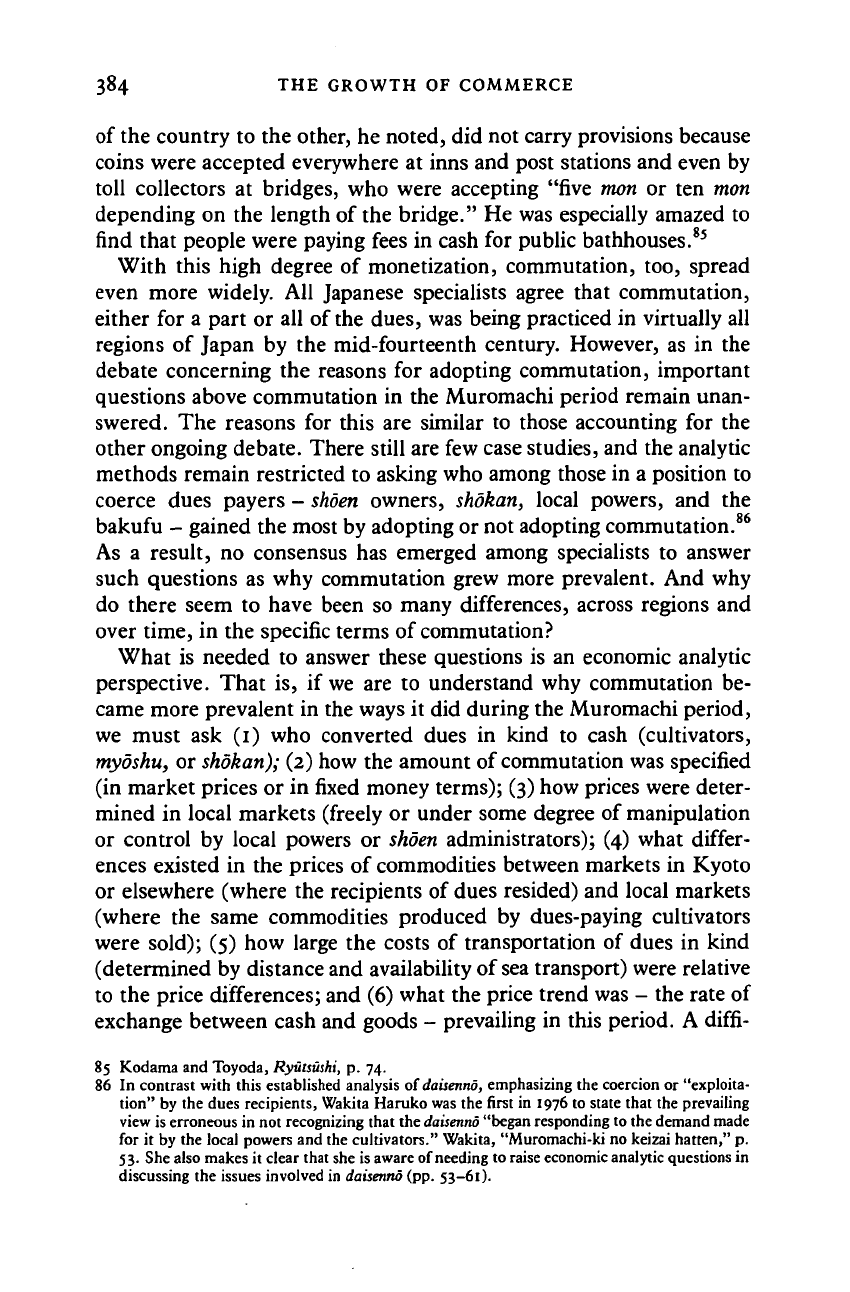
384 THE GROWTH OF COMMERCE
of the country to the other, he noted, did not carry provisions because
coins were accepted everywhere at inns and post stations and even by
toll collectors at bridges, who were accepting "five mon or ten mon
depending on the length of the bridge." He was especially amazed to
find that people were paying fees in cash for public bathhouses.
85
With this high degree of monetization, commutation, too, spread
even more widely. All Japanese specialists agree that commutation,
either for a part or all of the dues, was being practiced in virtually all
regions of Japan by the mid-fourteenth century. However, as in the
debate concerning the reasons for adopting commutation, important
questions above commutation in the Muromachi period remain unan-
swered. The reasons for this are similar to those accounting for the
other ongoing debate. There still are few case studies, and the analytic
methods remain restricted to asking who among those in a position to
coerce dues payers -
shoen
owners, shokan, local powers, and the
bakufu - gained the most by adopting or not adopting commutation.
86
As a result, no consensus has emerged among specialists to answer
such questions as why commutation grew more prevalent. And why
do there seem to have been so many differences, across regions and
over time, in the specific terms of commutation?
What is needed to answer these questions is an economic analytic
perspective. That is, if we are to understand why commutation be-
came more prevalent in the ways it did during the Muromachi period,
we must ask (1) who converted dues in kind to cash (cultivators,
myoshu,
or
shokan);
(2) how the amount of commutation was specified
(in market prices or in fixed money terms); (3) how prices were deter-
mined in local markets (freely or under some degree of manipulation
or control by local powers or
shoen
administrators); (4) what differ-
ences existed in the prices of commodities between markets in Kyoto
or elsewhere (where the recipients of dues resided) and local markets
(where the same commodities produced by dues-paying cultivators
were sold); (5) how large the costs of transportation of dues in kind
(determined by distance and availability of
sea
transport) were relative
to the price differences; and (6) what the price trend was - the rate of
exchange between cash and goods - prevailing in this period. A diffi-
85 Kodama and Toyoda, Ryutsmhi, p. 74.
86 In contrast with this established analysis of
daisenno,
emphasizing the coercion or "exploita-
tion"
by the dues recipients, Wakita Haruko was the first in 1976 to state that the prevailing
view is erroneous in not recognizing that the
daisenno
"began responding to the demand made
for it by the local powers and the cultivators." Wakita, "Muromachi-ki no keizai hatten," p.
53.
She also makes it clear that she is aware of needing to raise economic analytic questions in
discussing the issues involved in
daisenno
(pp. 53-61).
Cambridge Histories Online © Cambridge University Press, 2008
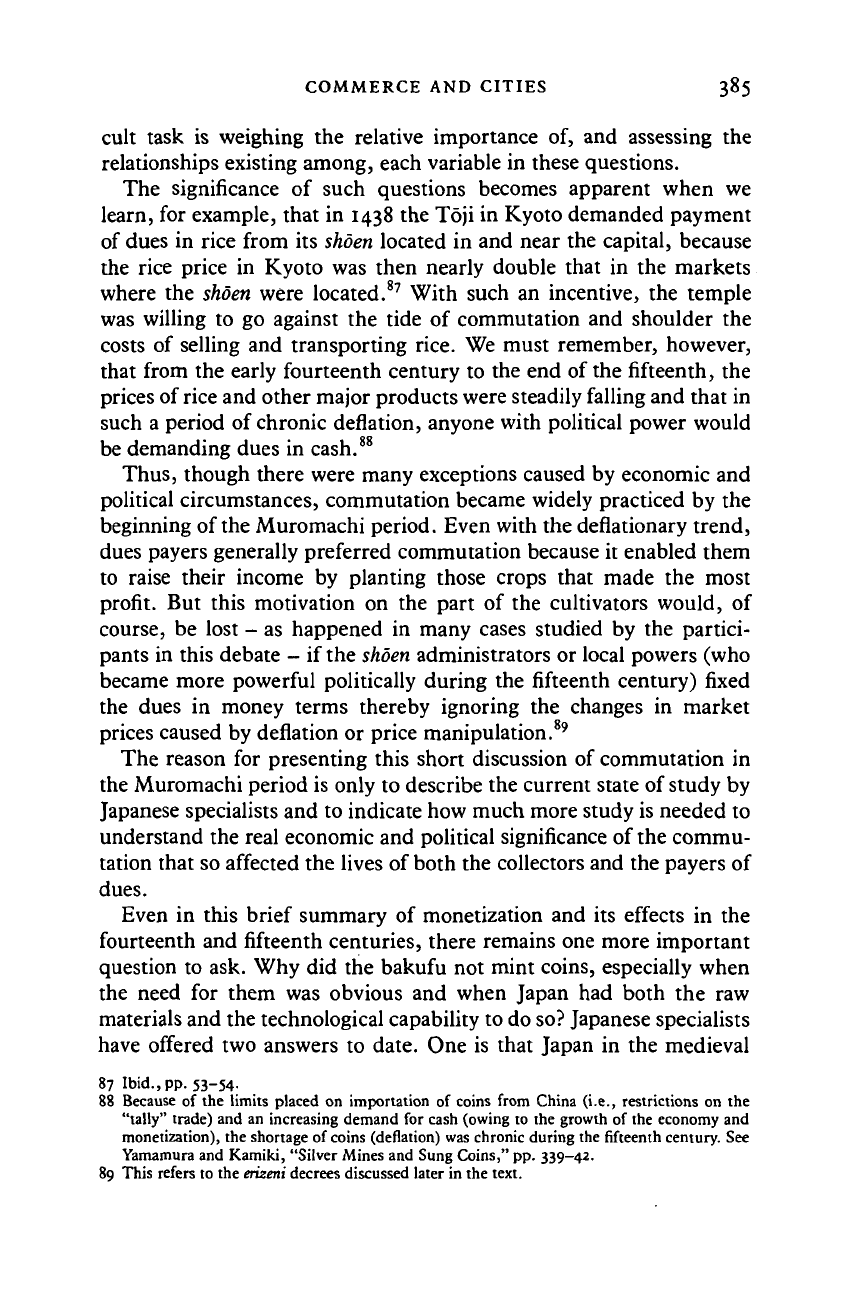
COMMERCE AND CITIES 385
cult task is weighing the relative importance of, and assessing the
relationships existing among, each variable in these questions.
The significance of such questions becomes apparent when we
learn, for example, that in 1438 the Toji in Kyoto demanded payment
of dues in rice from its shoen located in and near the capital, because
the rice price in Kyoto was then nearly double that in the markets
where the shoen were located.
87
With such an incentive, the temple
was willing to go against the tide of commutation and shoulder the
costs of selling and transporting rice. We must remember, however,
that from the early fourteenth century to the end of the fifteenth, the
prices of rice and other major products were steadily falling and that in
such a period of chronic deflation, anyone with political power would
be demanding dues in cash.
88
Thus,
though there were many exceptions caused by economic and
political circumstances, commutation became widely practiced by the
beginning of the Muromachi period. Even with the deflationary trend,
dues payers generally preferred commutation because it enabled them
to raise their income by planting those crops that made the most
profit. But this motivation on the part of the cultivators would, of
course, be lost - as happened in many cases studied by the partici-
pants in this debate - if the shoen administrators or local powers (who
became more powerful politically during the fifteenth century) fixed
the dues in money terms thereby ignoring the changes in market
prices caused by deflation or price manipulation.
89
The reason for presenting this short discussion of commutation in
the Muromachi period is only to describe the current state of study by
Japanese specialists and to indicate how much more study is needed to
understand the real economic and political significance of the commu-
tation that so affected the lives of both the collectors and the payers of
dues.
Even in this brief summary of monetization and its effects in the
fourteenth and fifteenth centuries, there remains one more important
question to ask. Why did the bakufu not mint coins, especially when
the need for them was obvious and when Japan had both the raw
materials and the technological capability to do so? Japanese specialists
have offered two answers to date. One is that Japan in the medieval
87 Ibid., pp. 53-54.
88 Because of the limits placed on importation of coins from China (i.e., restrictions on the
"tally" trade) and an increasing demand for cash (owing to the growth of the economy and
monetization), the shortage of coins (deflation) was chronic during the fifteenth century. See
Yamamura and Kamiki, "Silver Mines and Sung Coins," pp. 339-42.
89 This refers to the erizeni decrees discussed later in the text.
Cambridge Histories Online © Cambridge University Press, 2008
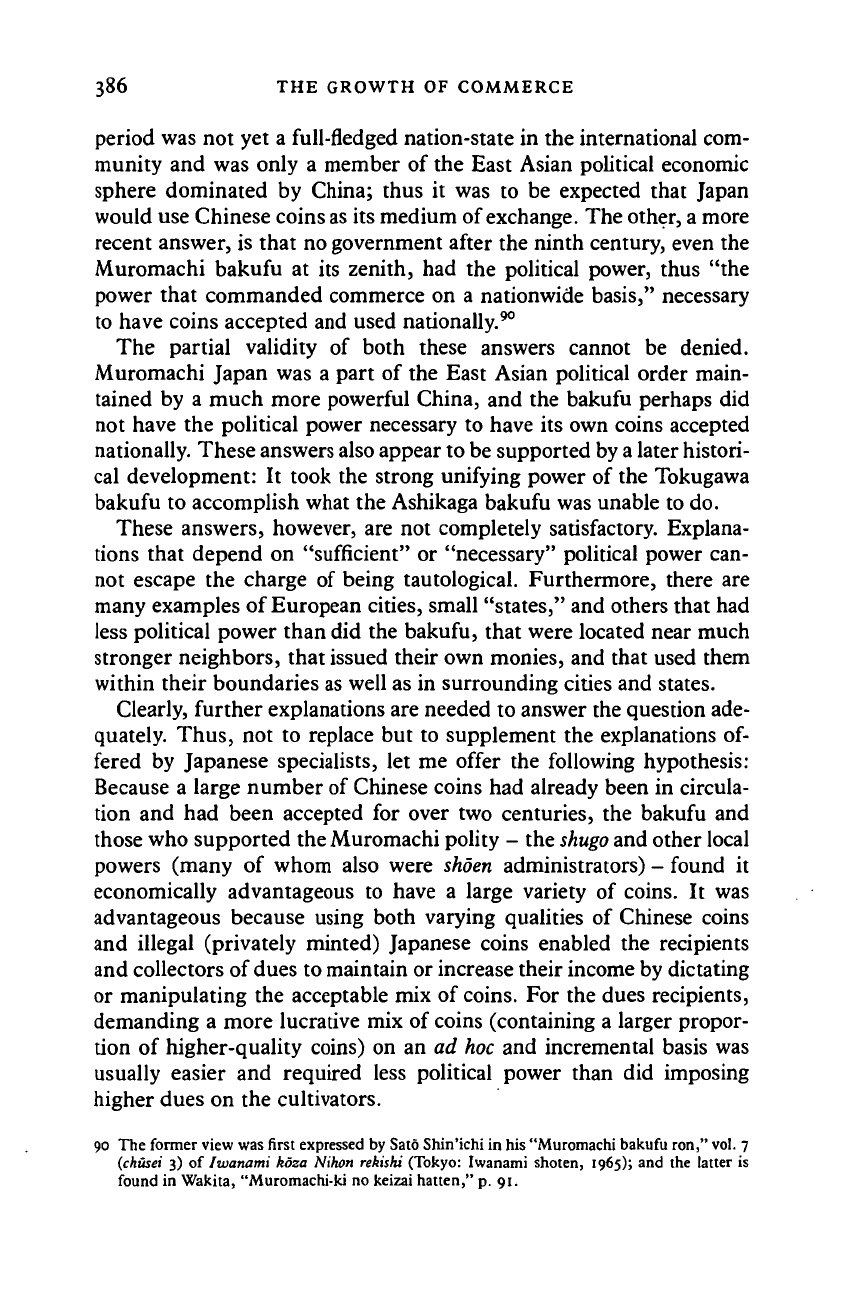
386 THE GROWTH OF COMMERCE
period was not yet a full-fledged nation-state in the international com-
munity and was only a member of the East Asian political economic
sphere dominated by China; thus it was to be expected that Japan
would use Chinese coins
as
its medium of exchange. The other, a more
recent answer, is that no government after the ninth century, even the
Muromachi bakufu at its zenith, had the political power, thus "the
power that commanded commerce on a nationwide basis," necessary
to have coins accepted and used nationally.
90
The partial validity of both these answers cannot be denied.
Muromachi Japan was a part of the East Asian political order main-
tained by a much more powerful China, and the bakufu perhaps did
not have the political power necessary to have its own coins accepted
nationally. These answers also appear to be supported by a later histori-
cal development: It took the strong unifying power of the Tokugawa
bakufu to accomplish what the Ashikaga bakufu was unable to do.
These answers, however, are not completely satisfactory. Explana-
tions that depend on "sufficient" or "necessary" political power can-
not escape the charge of being tautological. Furthermore, there are
many examples of European cities, small "states," and others that had
less political power than did the bakufu, that were located near much
stronger neighbors, that issued their own monies, and that used them
within their boundaries as well as in surrounding cities and states.
Clearly, further explanations are needed to answer the question ade-
quately. Thus, not to replace but to supplement the explanations of-
fered by Japanese specialists, let me offer the following hypothesis:
Because a large number of Chinese coins had already been in circula-
tion and had been accepted for over two centuries, the bakufu and
those who supported the Muromachi polity - the
shugo
and other local
powers (many of whom also were
shoen
administrators) - found it
economically advantageous to have a large variety of coins. It was
advantageous because using both varying qualities of Chinese coins
and illegal (privately minted) Japanese coins enabled the recipients
and collectors of dues to maintain or increase their income by dictating
or manipulating the acceptable mix of
coins.
For the dues recipients,
demanding a more lucrative mix of coins (containing a larger propor-
tion of higher-quality coins) on an ad
hoc
and incremental basis was
usually easier and required less political power than did imposing
higher dues on the cultivators.
90 The former view was first expressed by Sato Shin'ichi in his "Muromachi bakufu ron," vol. 7
(chusei 3) of Iwanami koza Nihon rekishi (Tokyo: Iwanami shoten, 1965); and the latter is
found in Wakita, "Muromachi-ki no keizai hatten," p. 91.
Cambridge Histories Online © Cambridge University Press, 2008
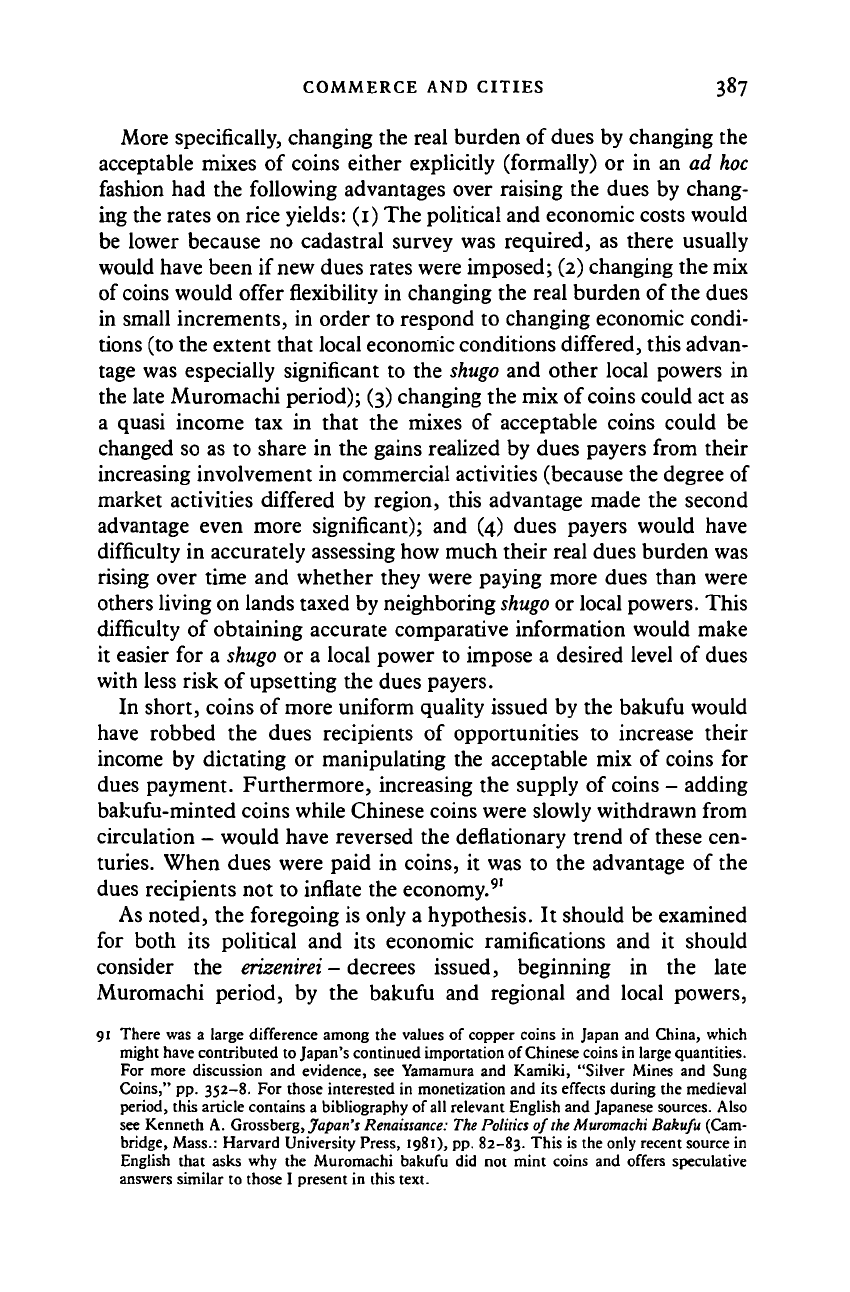
COMMERCE AND CITIES 387
More specifically, changing the real burden of dues by changing the
acceptable mixes of coins either explicitly (formally) or in an ad hoc
fashion had the following advantages over raising the dues by chang-
ing the rates on rice yields: (i) The political and economic costs would
be lower because no cadastral survey was required, as there usually
would have been if new dues rates were imposed; (2) changing the mix
of coins would offer flexibility in changing the real burden of the dues
in small increments, in order to respond to changing economic condi-
tions (to the extent that local economic conditions differed, this advan-
tage was especially significant to the shugo and other local powers in
the late Muromachi period); (3) changing the mix of coins could act as
a quasi income tax in that the mixes of acceptable coins could be
changed so as to share in the gains realized by dues payers from their
increasing involvement in commercial activities (because the degree of
market activities differed by region, this advantage made the second
advantage even more significant); and (4) dues payers would have
difficulty in accurately assessing how much their real dues burden was
rising over time and whether they were paying more dues than were
others living on lands taxed by neighboring
shugo
or local powers. This
difficulty of obtaining accurate comparative information would make
it easier for a shugo or a local power to impose a desired level of dues
with less risk of upsetting the dues payers.
In short, coins of more uniform quality issued by the bakufu would
have robbed the dues recipients of opportunities to increase their
income by dictating or manipulating the acceptable mix of coins for
dues payment. Furthermore, increasing the supply of coins - adding
bakufu-minted coins while Chinese coins were slowly withdrawn from
circulation - would have reversed the deflationary trend of these cen-
turies.
When dues were paid in coins, it was to the advantage of the
dues recipients not to inflate the economy.
91
As noted, the foregoing is only a hypothesis. It should be examined
for both its political and its economic ramifications and it should
consider the
erizenirei
- decrees issued, beginning in the late
Muromachi period, by the bakufu and regional and local powers,
91 There was a large difference among the values of copper coins in Japan and China, which
might have contributed to Japan's continued importation of Chinese coins in large quantities.
For more discussion and evidence, see Yamamura and Kamiki, "Silver Mines and Sung
Coins," pp. 352-8. For those interested in monetization and its effects during the medieval
period, this article contains a bibliography of all relevant English and Japanese sources. Also
see Kenneth A. Grossberg, Japan's Renaissance: The Politics of
the
Muromachi Bakufu (Cam-
bridge, Mass.: Harvard University Press, 1981), pp.
82-83.
This is the only recent source in
English that asks why the Muromachi bakufu did not mint coins and offers speculative
answers similar to those I present in this text.
Cambridge Histories Online © Cambridge University Press, 2008
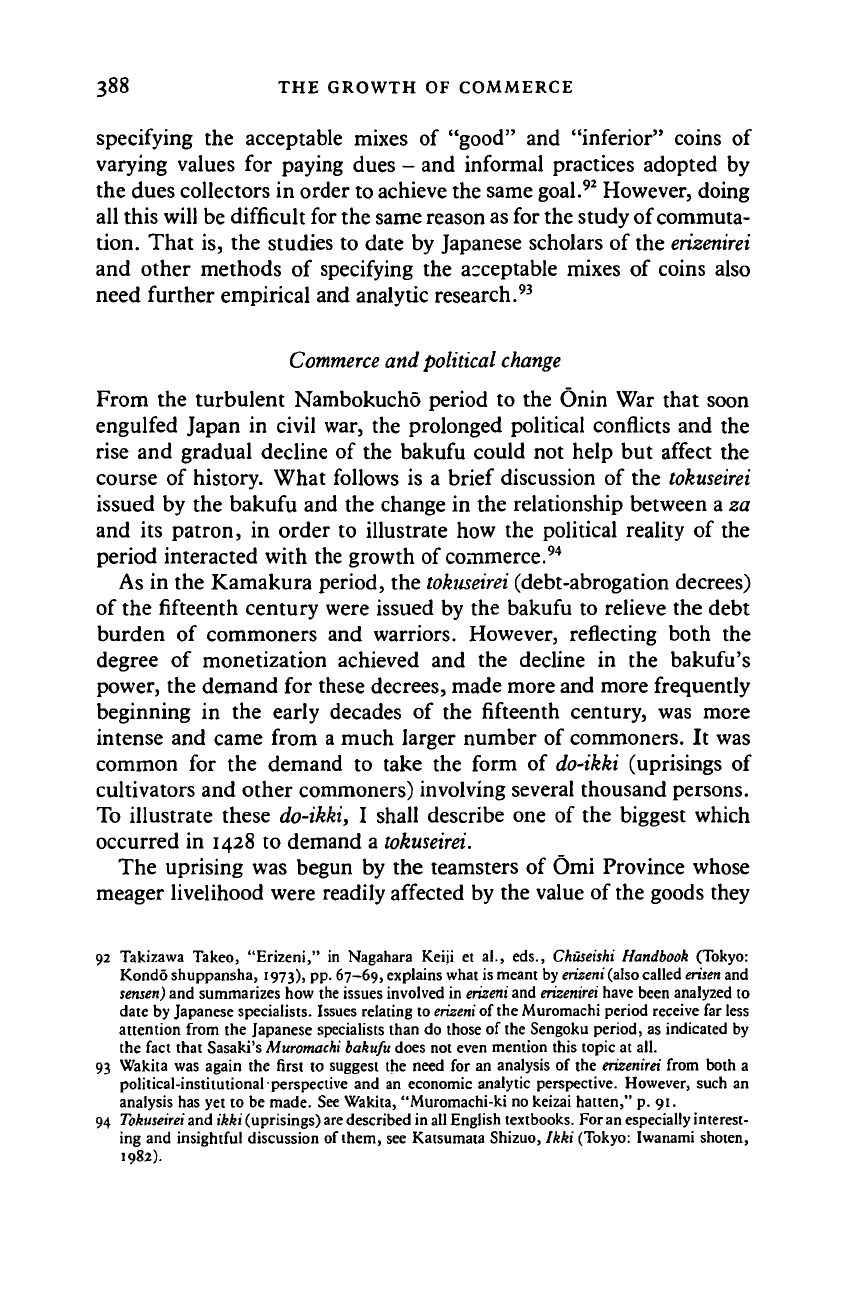
388 THE GROWTH OF COMMERCE
specifying the acceptable mixes of "good" and "inferior" coins of
varying values for paying dues - and informal practices adopted by
the dues collectors in order to achieve the same goal.
92
However, doing
all this will be difficult for the same reason as for the study of commuta-
tion. That is, the studies to date by Japanese scholars of the
erizenirei
and other methods of specifying the acceptable mixes of coins also
need further empirical and analytic research.
93
Commerce
and political
change
From the turbulent Nambokucho period to the Onin War that soon
engulfed Japan in civil war, the prolonged political conflicts and the
rise and gradual decline of the bakufu could not help but affect the
course of history. What follows is a brief discussion of the tokuseirei
issued by the bakufu and the change in the relationship between a za
and its patron, in order to illustrate how the political reality of the
period interacted with the growth of commerce.
94
As in the Kamakura period, the
tokuseirei
(debt-abrogation decrees)
of the fifteenth century were issued by the bakufu to relieve the debt
burden of commoners and warriors. However, reflecting both the
degree of monetization achieved and the decline in the bakufu's
power, the demand for these decrees, made more and more frequently
beginning in the early decades of the fifteenth century, was more
intense and came from a much larger number of commoners. It was
common for the demand to take the form of do-ikki (uprisings of
cultivators and other commoners) involving several thousand persons.
To illustrate these do-ikki, I shall describe one of the biggest which
occurred in 1428 to demand a tokuseirei.
The uprising was begun by the teamsters of Omi Province whose
meager livelihood were readily affected by the value of the goods they
92 Takizawa Takeo, "Erizeni," in Nagahara Keiji et al., eds., Chuseishi Handbook (Tokyo:
Kondo shuppansha, 1973), pp. 67-69, explains what is meant by erizeni (also called
erisen
and
semen) and summarizes how the issues involved in erizeni and
erizenirei
have been analyzed to
date by Japanese specialists. Issues relating to
erizeni
of the Muromachi period receive far less
attention from the Japanese specialists than do those of the Sengoku period, as indicated by
the fact that Sasaki's Muromachi bakufu does not even mention this topic at all.
93 Wakita was again the first to suggest the need for an analysis of the erizenirei from both a
political-institutional perspective and an economic analytic perspective. However, such an
analysis has yet to be made. See Wakita, "Muromachi-ki no keizai hatten," p. 91.
94
Tokuseirei
and ikki (uprisings) are described in all English textbooks. For an especially interest-
ing and insightful discussion of them, see Katsumata Shizuo, Ikki (Tokyo: Iwanami shoten,
1982)-
Cambridge Histories Online © Cambridge University Press, 2008
